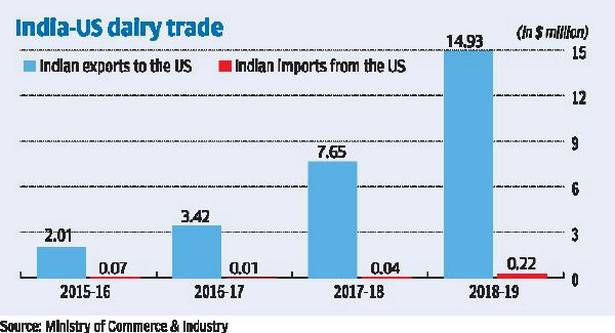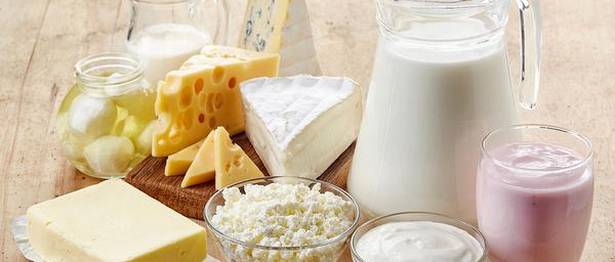The upcoming visit of US President Donald Trump to India may see the contours of the Indo-US deal being finalised in specific sectors, which is also likely to include allowing for market access for US dairy products in India. This move is likely to have significant adverse consequences on the prospects of the fledgling Indian dairy industry. Let’s first set a brief context by highlighting the importance of the dairy sector in India’s overall economic schema.
The dairy sector not only provides employment to the rural workforce, but is also a significant contributor to the national economy. While the share of agriculture and allied (A&A) sector in the gross value added (GVA) has consistently declined from 18.2 per cent in 2014 to 17.2 per cent in 2017, the share of livestock to GVA has increased from 4.4 per cent to 4.9 per cent during the same period. Importantly, within the A&A sector, among the key livestock products, milk and milk products have the highest share, at around 67.2 per cent in 2017.
The dairy sector plays a pivotal role in aiding the reduction of rural poverty and inequity, in addition to ensuring the food security of millions of rural households. Notably, according to a report by the Agriculture Skill Council of India, while crop production generates employment for the rural workforce for an average of 90-120 days in a year; the dairy sector plays a major role in providing alternative employment opportunities throughout the year.
In fact, in the recent years, milk and milk products have become the largest agricultural commodity, with their output standing at more than 20.6 per cent of the combined output of paddy, wheat and pulses. Thus, there is no gainsaying the importance of the dairy sector as one of the important sectors of the Indian economy.
Coming to the dynamics of the dairy trade with focus on the US and India, the data shows that the US is a net exporter in dairy trading, with its share in global exports standing at 4.9 per cent as opposed to an import share of around 2.8 per cent in 2018. In contrast, the share of India is minuscule at 0.3 per cent and 0.06 per cent in global dairy exports and imports, respectively, in 2018.
However, bilateral trade in dairy products between the US and India reveals a very variant picture. While the dairy exports to US have increased by almost seven times from $2.1 million in 2015-16 to $14.9 million in 2018-19, the pace of imports from the US has shown a moderate uptick (see Chart). This translates into a sharp jump in trade surplus for India from $1.94 million to $14.41 million during the comparable time period against the US.

Trade surplus
The underlying broad reasons behind India’s trade surplus with the US in dairy is elucidated as follows. First, a glance at the product-wise trade statistics from India reveals that ‘melted butter’ (ghee) has the largest share in exports to the US at 56 per cent, followed by ‘processed cheese’ (21 per cent), butter (10 per cent), ‘other cheese’ (3.9 per cent), and ‘other fats’ and ‘oils derived from milk’ (3.5 per cent) in 2018-19. India has a comparative advantage in the export of ‘melted butter’ and ‘processed cheese’ to the US because the cost of production of both these products is cheaper in India (The World Dairy Situation report, 2019).
Second, the lower average final bound duties on dairy products in the US help provide a boost to diary exports from India. According to the World Tariff Profiles, 2019, an average final bound duty on dairy products in the US is around 19 per cent, as against close to 64 per cent in India.
The third and most critical reason for India’s high trade surplus in dairy vis-à-vis US is attributable to ‘cultural and religious sentiments’. The latter implies that the Indian authorities’ mandatory certification from the concerned US agency which states that “the source animal should not have been fed animal-derived blood meal”, weeds out significant imports from the US. This mandatory certification has been stated by the Ministry of Commerce as non-negotiable, as it carries sensitive connotations for the religious sentiments of a majority of the Indian population.
Disadvantage, India
If India goes ahead with the signing of the deal on allowing market access of US dairy products in the Indian market, then the former stands to lose out in a big manner. In 2017, India contributed 21 per cent of the world’s milk production, thus making it the largest milk producer in the world. This has been made possible by the almost 73 million marginal and landless farmers who directly work in the dairy sector and hold, on average, two milch animals per farmer.
In addition, Indian farmers enjoy favourable terms of trade in the dairy arena, with their share in the consumer price standing at around 60 per cent, which happens to be the highest in the world (as per the International Farm Comparison Network’s Dairy Report, 2018). However, in the US, there are around 0.04 million dairy farmers holding an average of 241 milch animals per farmer. Though these farmers are basically large dairy farmers who benefit from economies of scale, they only get around 43 per cent of what the consumer pays, which is 1.4 times lower than that of India.
Further, according to The World Dairy Situation,2019 report, milk yield per cow in the US is the highest in the world, standing at 10,500 kg per cow as against 1,715 kg per cow in India, which is the second-lowest in the world after Pakistan. Importantly, a dairy farmer in the US is able to sell milk at a price 16.6 per cent above the average world market price, as compared with the similar number standing at 15.6 per cent in India.
Thus, it is evident from the numbers that despite lower milk yield and dominance of small and marginal farmers in dairy activity, India is comfortably placed to produce milk at a cheaper rate. Thus, opening market access for the sector is likely to place these dairy farmers in a disadvantaged position in relation to the large-scale dairy farmers in US.
The US dairy industry claims that the proposed trade pact with India has the potential to increase dairy exports to India up to $100 million. As per our estimates, had the India-US trade deal in the dairy sector already been in force, India would have run up a dairy sector trade deficit of $85 million today, instead of the 2018-19 trade surplus of $14.71 million. This is not good news for the Indian dairy industry, as the trade deal will not only adversely affect the industry as a whole but also the socio-economic conditions of millions of small, landless and marginal farmers — especially women, who are active in this industry. It will affect the business activity of small dairies and dairy cooperative players. It is likely to temper the sentiments in the rural economy, which is already dealing with a gamut of problems at present.
Last but not the least, the deal could play spoil sport in fulfilling the Prime Minister’s clarion call of doubling our farmers income by 2022. Thus, it will be prudent on the part of Indian authorities to take adequate precautionary measures in proceeding ahead with the trade pact with the US on dairy products.
Parida is research fellow, Verghese Kurien Centre for Excellence, Institute of Rural Management, Anand. Bhardwaj is an independent researcher based in Delhi. Views are personal.

















